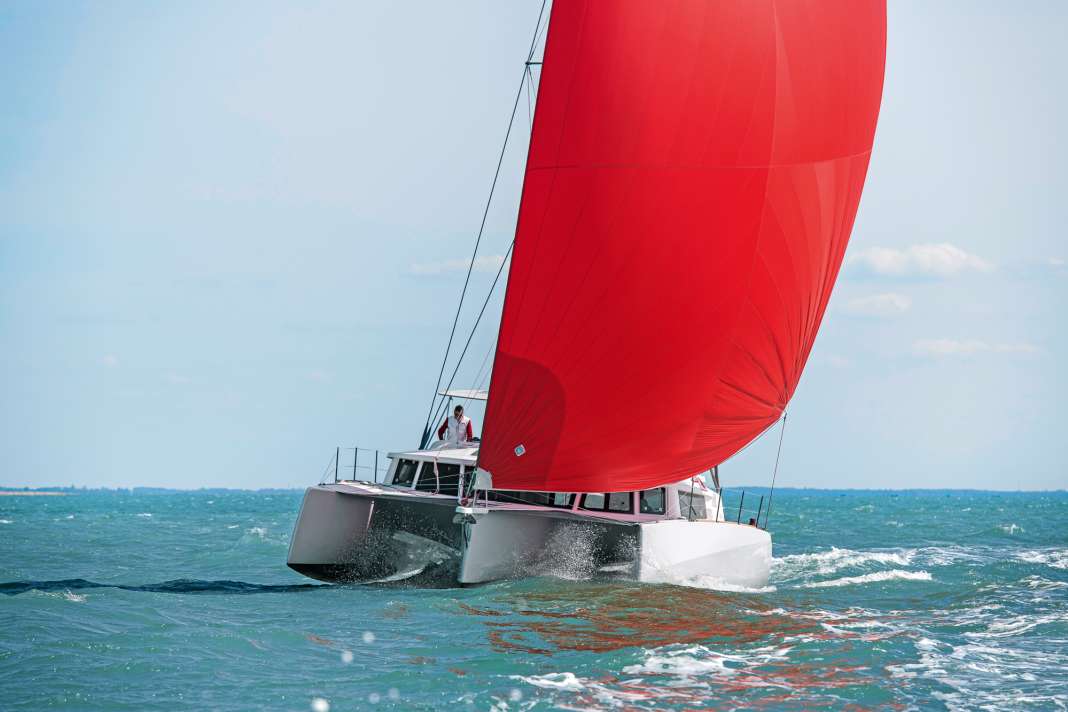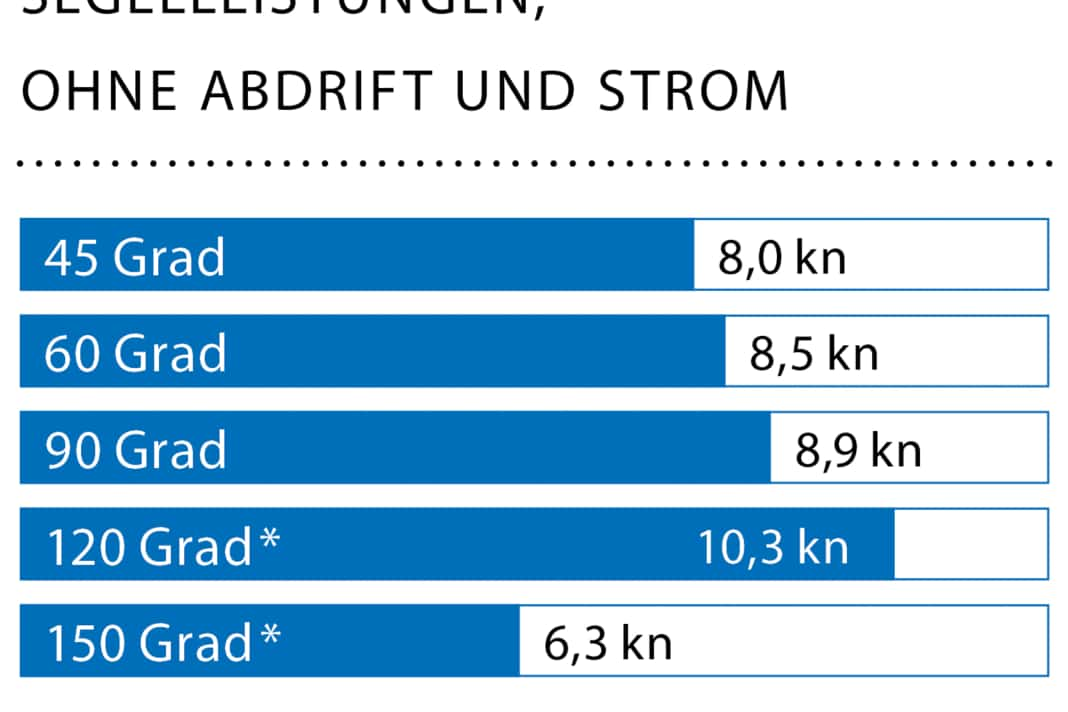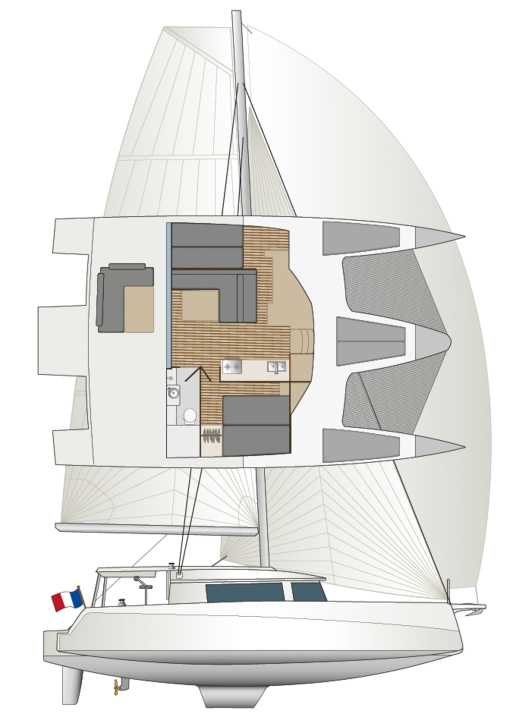





Just over ten years ago, French ocean sailor and multihull expert Eric Bruneel presented his vision of a new, modern touring boat with the Neel 45. The idea: to combine the advantages of a comfortable, spacious cruising catamaran with the powerful sailing characteristics of a trimaran. At the time, not many people wanted to believe in the success of the unconventional project - the plan was too unusual, the production too costly and technically difficult to realise, were the supposed killer arguments.
The competition
Today, all doubters should be proved wrong. The shipyard has built over 100 large trimarans in the first decade of its existence. For a recognised niche product, this can be considered a respectable success. And Neel-Trimarans knows no stopping: In recent years in particular, product development has gone from strength to strength.
With the Neel 51 the shipyard has delivered a boat that is conceptually close to a conventional cruising catamaran, as the side hulls have also been designed to be cosy and are directly connected to the saloon. The boat was awarded the title of European Yacht of the Year in 2018. The boat presented in 2020 is somewhat smaller Neel 47 out. The outer hulls are also habitable, but can only be reached via separate companionways.
Unusual layout
With the Neel 43, the shipyard returned to the concept of the original Neel 45 model in 2021, which we first presented as a "special boat" in YACHT 9/2013. In short: three hulls that together serve as a platform, with a large and maximally wide cabin house on top.
Living on one level was the theme then as it is now with the new ship. The hulls themselves, on the other hand, are not intended as living space, but primarily serve as storage areas and for the installation of on-board technology.
With the Neel 43, the shipyard aims to capitalise even more consistently on the boom that has long been driving the multihull segment. To this end, the already increased production capacities of the trimaran builders in western France have been significantly expanded once again. Eric Bruneel has purchased additional production space for the company premises in La Rochelle. The latest and smallest model is now built there on an assembly line that is good for 22 units per year. With a total annual production of 35 boats, it is clear that the new Tri is set to become the brand's bestseller.
The Neel 43 does not have to fear direct competition
The shipyard need not fear any competition. There are large trimarans from Dragonfly or Rapido that are also suitable for travelling. Compared to the Neel, these offer advantages in the harbour because their floats can be swivelled or folded in and the width can be reduced. However, they are designed differently. Their main focus is on good sailing characteristics; in terms of space, however, they do not quite come close to the Neel designs.
Conventional cruising catamarans, on the other hand, offer at least as much or even significantly more space. However, the mostly heavy and rather sluggish two-hulled boats lose out to the Neel 43 in terms of performance and sportiness. It is therefore a kind of hybrid: It is faster than most cats and more comfortable than the more powerful tris.
It was able to demonstrate its potential during the YACHT test in the bay of La Rochelle. The conditions were perfect, with winds of between 15 and 18 knots, some swell and waves around one metre high.
The Neel 43 has sporty genes
With the 115 per cent overlapping genoa and moderately flared batten size, the test boat, construction number 1, is loaded as standard. Under this sail, the Neel 43 achieves a tacking angle of 90 degrees, which is respectable for a multihull. More remarkable, however, is the speed upwind: the trimaran logs an average of 8.0 knots. This promises good etimes, even on longer trips against the wind.
The boat is a lot of fun on the courses with a gennaker or code zero. This is not only because of the even higher speed, which sometimes reaches double figures, but also because the trimaran can be steered very actively and with a lot of feeling with only one rudder blade on the centre hull. It is also surprisingly responsive - a characteristic that is all too often lacking in cruising catamarans.
However, you have to steer through the tacks quickly, because the Neel with its three hulls stops quite quickly when you tack. Once "stuck" in the wind, the only way to get back on course is to hold the genoa back or use the engine. This can happen quickly.
Although the sheets for the main and genoa as well as all trim lines and halyards are steered directly in front of the helm, handling the overlapping genoa is challenging for solo sailors and requires practice. However, the helm cockpit is large enough for two people to work there unhindered.
Low resistance
The design was created by Marc Lombard. The slender side hulls are slightly shorter than the central hull and have an underwater hull with a pronounced bulge. In this way, Lombard wants to ensure that the Neel stands evenly and stably on all three hulls in the harbour and does not tip sideways, as racing tris often do. At the same time, the waterline should remain as short as possible and thus the wetted surface as small as possible. Under sail, the geometry is designed so that the boat always heels slightly upwind and the float is permanently out of the water upwind.
The Neel 43 sails beautifully stiff and glides through the waves with its sharply cut, negative wavepiercer-style stem with almost no perceptible resistance; the rolling movements often noticeable on large cruising cats in rough seas are almost completely absent. Instead, the boat gives the impression of moving more like a monohull.
Neel 43 uses more sustainable materials for the first time
However, there is one weakness: because the hulls are relatively close together, the sea literally splashes back and forth between the flanks when travelling fast in the narrow tunnel. It is not uncommon for a veritable fountain of spray to hit the outside cockpit from aft, where you could otherwise sit comfortably and relax in a well-protected position. The developers at Neel are aware of this and are already working on solutions with flexible fabric water deflectors between the protruding sterns.
The shipyard builds all parts of its trimarans as sandwich constructions using the complex but weight-saving vacuum infusion process. With the new Neel 43, the shipyard is now also changing the materials used and for the first time is focussing on more sustainable alternatives. Wherever possible, the components are now constructed using flax fibres instead of glass fibres; natural cork or foam panels made from recycled PET are used as the core material.
Neel also goes further than other boat builders when it comes to safety. All three hulls have a crash box in the bow and are also sealed off several times. His trimarans should be unsinkable under all circumstances, assures shipyard boss Eric Bruneel.
Loft-style living at Neel 43
To describe the interior as homely or even cosy would be an exaggeration. Instead, the saloon is dominated by the glossy white surfaces of the almost continuous interior shells. There are only a few wooden veneers, and only in the area of the galley built into the side of the saloon. Everything else: Plastic - beautifully made and visibly well fitted, but not particularly cosy.
On the other hand, the sober interior fits in quite well with the bright, open and almost loft-like interior design. The modern look and the young ambience are certainly appealing. The layout, on the other hand, is special because it is hardly comparable.
The individual living and functional areas are essentially distributed over an open-plan area. Only the owner's cabin on the starboard side is separated, but remains visually connected to the saloon thanks to a long row of windows. Curtains provide privacy if required. The second double berth on the port side, on the other hand, is openly integrated into the saloon. This area can only be separated with curtains and is suitable, for example, as a lounger for a nap in between, as a pilot's berth on long trips or as a play area for the children. A simple but smart idea in this respect.
Sober functionality
The Neel 43 also has a double cabin in the foredeck of the centre hull, which can be separated with a sliding door; however, it is more of a makeshift accommodation. As a fully enclosed GRP module in white throughout, the cabin has the charm of a refrigerator. The sleeping area with a shoulder width of just 1.25 metres is also barely suitable for two adults. Cushions can be inserted into the forepeaks of the outer hulls as additional berths. However, the comfort in these "cabins" no longer fulfils even the most modest requirements.
As an alternative and for an extra charge, owners can order the saloon table as a lowerable version. Together with inlay cushions, the L-shaped sofa can be converted into a double lounger. After all, the ambience there is somewhat cosier than in the bows, but the spatial and acoustic proximity to the open lounger on the port side remains a drawback. The Neel cannot be recommended for more than four to a maximum of six people in the long term - not least because there is only one bathroom, which is also relatively small and does not have a separate shower compartment, which is standard for a cruising boat of this size today. By way of comparison, cruising boats of the same length and similar width, such as the Leopard 42, have three or four double cabins, each with its own bathroom and usually separate showers.
The Neel concept provides significantly more space for the navigation system, which is almost reminiscent of a real command bridge with its extensive on-board electronics. Here you sit very comfortably on a long bench in the style of a chaise longue with a view in the direction of travel as well as to the side. With the help of the remote control from the autopilot, the Neel 43 can also be easily steered from the inside, and a second engine control lever is available on special request.
The Tri is attractive in its own way - just not for everyone
The galley fulfils its purpose as a long side row. Thanks to the covers over the double sink, the work surface is large enough and there is no shortage of storage space here at least. For the rest of the interior fittings, however, the range of shelves and cupboards is sparse. Instead of proper cupboards or fixed dovetail nests, Neel only installs fabric bags for small items. Eric Bruneel argues with weight savings, which undoubtedly plays a role in pure racing trimarans. However, the lack of storage space in the living area is a real drawback when the boat is designed as a cruising boat.
A hatch in the saloon floor leads into the large and limited-access technical room in the central hull. The entire on-board technology, including the stainless steel tanks for fresh water and fuel, is very neatly installed and easily accessible here. The shipyard is currently working on possible alternatives to the 50 hp built-in engine from Volvo Penta. A hybrid system or even a fully electric drive would be possible, for example. However, the solutions for this have not yet been finalised for the Neel 43 and are therefore not listed as an option for the time being.
Its unique conceptual position on the market, its lively sailing characteristics and the price make the Neel 43 interesting for ambitious cruising sailors. The only real compromises are the limited number of berths and the lack of storage space in the saloon and cabins.
The measured values for testing the Neel 43




The Neel 43 in detail

Technical data of the Neel 43
- Design engineer: Marc Lombard
- CE design category: A
- Torso length:12,90 m
- Width:7,40 m
- Depth:1,50 m
- Weight:9,0 t
- Mast height above waterline:19,0 m
- Mainsail:58,6 m2
- Furling genoa (115 %):43,4 m2
- machine (Volvo P.):36 kW/49 hp
Hull and deck construction
GRP sandwich with PET foam core. All parts built with vacuum infusion. Fuselage reinforcements made of carbon fibre
Price and shipyard
- Base price ex shipyard:483,700 € gross
- Guarantee/against osmosis: 2/2 years
As of 11/2023, how the prices shown are defined can be found here !
Shipyard
Neel-Trimarans, La Rochelle (France); www.neel-trimarans.com
Distribution
Dealer network
YACHT rating
The independent concept of the Neel 43 requires some compromises, but results in an attractive whole. The interior looks sparse, and it is. On the other hand, the Tri shines with fast sailing characteristics and an attractive price
Design and concept
- + Many innovative ideas
- + Attractive pricing policy
- - Only one wet room
Sailing performance and trim
- + High performance potential on the wind
- + Agile and responsive
- + Pleasant sea behaviour
Living and finishing quality
- + Living on one level in loft style
- + Open, airy layout
- - Hardly any storage space inside
Equipment and technology
- + Sustainable construction
- + Internal shrouds
This article first appeared in YACHT 18/2021 and has been updated for this online version.

